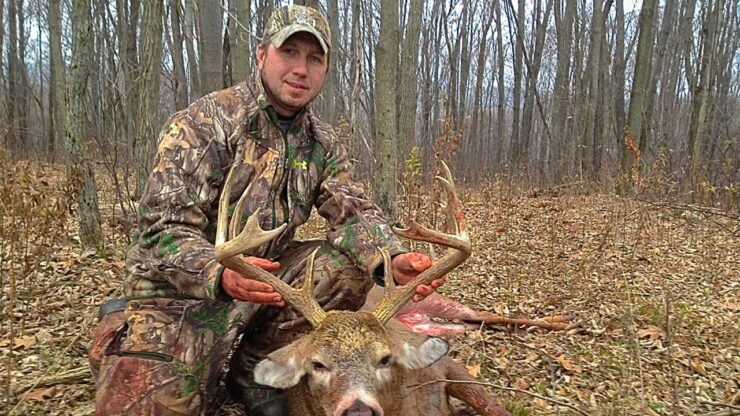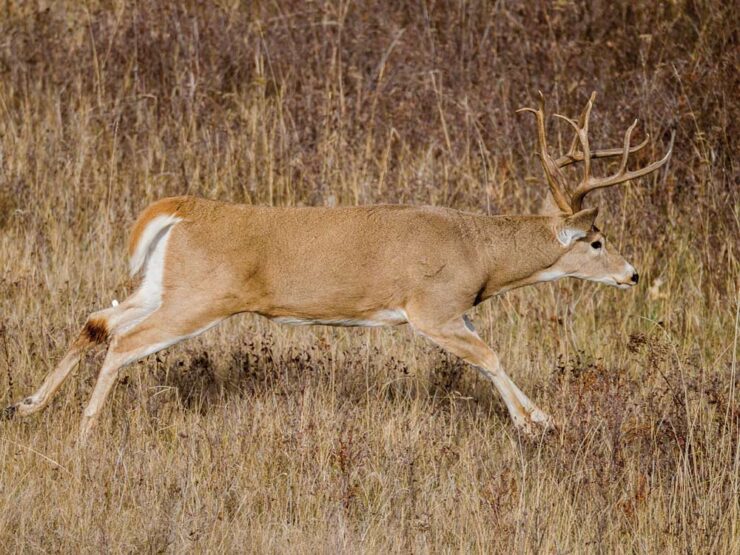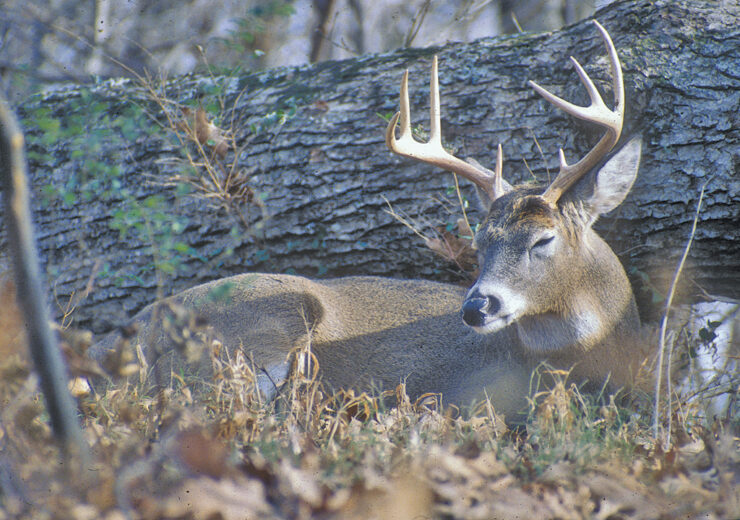The ethical hunter will always pass on questionable shots at deer. Most hunters have a deep admiration for North Americas #1 big game animal. This respect for the animal demands that you only take shots that your skill level allows. This will vary from hunter to hunter. I am admittedly at the bottom of the scale when it comes to shooting. I just don’t do it enough during the offseason to improve my skill level or to actually determine what I am truly capable of.
Despite my admitted lack of Danial Boone like shooting skills, I still make the vast majority of my shots at deer. I pride my self on not wounding deer. I do this by limiting myself almost exclusively to shots at standing deer that are unaware of my presents. Even still, as every hunter will experience if he hunts long enough, there will come a time when you will be required to track down a deer that didn’t go down quite like you planned. This is where most hunters are lacking and fall down on the job.
The number one reason that most hunter fail to recover recoverable deer is not because of lack of knowledge. It is most often a case of lack of willingness to try. Tracking can be fun at first but when the trail quickly goes cold the willingness to keep looking usually goes quickly as well. It has amazed me what some hunters won’t do to recover their deer.
Think about it. You have put in many many hours sitting in a deer stand waiting and hoping for that buck to walk by. You have endured cold, mosquitos, hours of complete bordom just for that hope, that possibility that a buck might walk by. Well when it finally does and something goes wrong (or sometimes not) shouldn’t you at least put in one tenth of that effort to find that deer??? Here are a couple of examples of what some hunters, and I use that terminalogy loosely, have done.
My brother years ago went on a deer hunt with a friend of his from school. At this point neither he nor I had ever been deer hunting. Well it turns out that the friend who will remain nameless shot at and hit a very small buck. The deer ran off and the friend and my brother later tried to track down the deer. My brother Stephen asked his friend where he had been aiming when he shot. The friend gave him a funny look and said matter of factly, “At the deer!” Stephen left it go at that.
Well the deer was moveing quite well but was also leaving a good blood trail. They followed the trail for a few hundred yards until they came to a small creek. The blood trail stopped at the waters edge. It was obvious that the deer had crossed the creek. Well not only did the trail stop at the creek but so did the tracking. Stephen being a guest on his first deer hunt even thought it strange that such a small obsticle would bring the search to such an abrupt halt. Especially considering the deer was leaving such a good blood trail. This deer was obviously what I would put in the catagory of collectable.
Another example of what happens, probably more frequently, on hunts is something like this. This hunt was described to me by a hunter on an adjoining piece of land. We were talking about what we had seen and other such things when the subject turned to a particular crossing on a power line that was about 150 yards away from where we stood. We we talking about how that was a good crossing for bucks. He went on to relay a story that went something like this.
He was sitting on the power line when a nice buck stepped out on the power line at the crossing. He took his rifle and settled the crosshairs on the buck and shot. The buck immediately took off running and was totally out of sight after it had traveled only about 7 yards. To him the deer didn’t look like it was hit. And since he was taking a free hand shot at such a long distance he really didn’t expect to hit the buck. Well he said “I don’t know why but for some reason I went over and looked. The 7 point buck was dead only a couple of feet from the power line.” This man recovered his deer but he came very close to not even looking.
Incidents like this are far to common. Often out of ignorance, when someone thinks they can tell that they missed clean just by the deer immediate reaction after the shot. Now I can preach till I am blue in the face and not convince you to put forth the effort that you should to recover your deer, that I can’t change unless you want too. That part boils down to your character. The other part of recovering your deer is what we will now cover. The actual tracking and reading sign left by wounded deer, what that sign means, and what to do with that information.
Where a deer has been hit will determine how the deer is likely to react and therefore will also greatly impact what the hunter should do to recover the deer. Deer shot with a bow will sometimes jump or react to the hit but then immediately look around not knowing what happened and then go back to feeding or whatever activity they where doing. This happens because the broadhead can sometimes cut cleanly enough that no pain is felt. I was once cut by a barded wire fence but didn’t know until my cousin told me I had blood running down my leg all over my socks. With deer as with people however this is not the norm but it does happen. I doubt that a gun hunter will ever see a gun shot deer react this way.
Gut shot deer will often jump with an arched body into the air when hit. And will sometimes run hunched up as they make their escape. Lung shot deer sometimes do this also so its not written in stone. You can recognize a gut shot deer sometimes by findind blood with greenish, brown particles mixed in or sometimes larger bits of partially digested food. As often however you will find nothing. Not only do gut shot deer run farther then other wounded deer they also unfortunately have a tendency to not bleed much. The deers intestines often block up the entrance and exit holes, thereby minimizing bleeding. Gut shot deer will often run long distances before dying or laying up and they usually don’t die quickly either. If you suspect you have gut shot a deer and you are hunting in the evening the best thing you can do is to backoff and try trailing the next morning. If you shot it in the morning then bring all of your equipment back to camp and have something to eat before going back, hopefully with a couple of buddies to find your deer.

Lets assume you have gut shot a deer and it is leaving no blood trail. After the designated waiting period has ended where should you look? First you should take off down the path that the deer took and try to guess the path that the deer continued to take. Check a few of the most likely routes and if no deer is found then return to the starting point and regroup. You should now check the deers back trail. Deer do not like running head long into an area before checking it out. So often deer will circle back to the area that they had just left before being shot.
I almost lost a deer to just such a senario. I was hunting over a thick cutover. I shot a buck from almost above and the downward angle of the bullet didn’t allow for both lungs to be hit. The buck was headed due East when I shot. He turned and started running straight South at the shot. Since it was so thick I quickly lost sight of the deer but he was easy to follow by ear because he was crashing through so much brush. After he had run South about 35 or 40 yards I could easily hear that he had now turned back to the East and then I heard a big crash and then nothing. At this point it seemed as though everything had gone according to plan.
I went to where the deer had been shot and I found hair. I then tried to find a blood trail. This was done for the fun of it since I thought I new exactly where the deer had fallen. As I travelled down the bucks path I could find no blood. Apon reaching the spot where I had heard the crash I laid my gun against a tree. This area was so thick visibility was only 5 to 20 yards max. I started making ever widening circles around the tree, but could find no sign and worse no deer. I was then presented with a sickening scenario. No blood trail and woods as thick as they come. I put in hours searching the area that the deer had gone with nothing to show. Finally I had had enough. Hours of searching wasted.
A buck, WASTED. I was sick to my stomach knowing the deer would die and not knowing what I could have done differently. As I started to leave I set my gun against a tree and decided to search the area to the West of where I had last heard the deer. Remember he had been running East. Also remember the deer was headed East when I shot. I started to circle my gun in ever widening circles. After a short while I gave up. But where was my gun. I had a hell of a time finding my gun even though I never got more than 50 yards from it. It was just so thick. Well as luck would have it while searching for the gun I came across a large pool of blood where the deer had laid up. I quickly found my gun and returned. I found the buck only 7 yard from that pool of blood.
This example points out that deer will often circle back after being hit. The deer startled at the shot and being hit, immediately ran away from the sound and the direction that the hit had come from. As he approached a three wheeler trail he turned East. All the while making noise. At this point he regained his composure stopped and decided his present course was not where he wanted to go. No telling what lies ahead of him to the East, better to stop and head back West where I know it was safe. This was now done in typical whitetail fashion, silently!
So now that you have checked the back trail to no avial now what? That depends on the lay of the land. If the land is fairly open then use a technique I have used successfully. I call it the grid system. Walk in a straight line searching the ground as you go. After you have traveled as far as you are willing to go then make another search back but slightly to the side. Toilet paper can be used to help guide you and it is biodegradable so no littering worries. Continue doing this until you have found your deer.
If you still have failed to find your deer all hope is not lost. Gut shot deer will undoubtably head towards water. So if there is a pond or small stream nearby you should then search up and down its banks. After this has been done you only have one more option. Wait for the birds to show you the deer. Return the next day and look for any unusual bird activity. Crows, buzzards, even smaller birds can tip you off to the deer location. If you see nothing the next day then return everyday for awhile. Hopefully this will at least let you recover the antlers.
This is a senario that you hopefully won’t encounter, and good shot selection can all but eliminate this from happening. The above technique will work on any deer regardless of where it was hit. Remember the gut shot is the worst case senario. Let me list some other facts that you can use to help recover your deer.
1. Frothy blood indicates a lung hit.
2. This blood is often pink in appearance. Dark blood might indicate a liver shot.
3. Wounded deer have a tendency to want to run down hill as apposed to uphill.
4. Anytime you jump a deer that has been hit back off and give it time to die.
5. Deer hit in the chest that don’t die immediately ususlly feel weak and will bed up extremely close to where they were hit. Sometimes not much more than 50 yards away.
6. Before you get down sit and analyze the last area the deer was seen. Make a mental note of specific trees. Once you get down it is amazing how different the woods look.
7. Mark your trail as you follow a blood trail. This will give you a visual indication of the path the deer was taking. And you will not have to worry about messing up a sparse blood trail and then loosing track of where the deer was headed and where the last sign was found.
8. When you find your deer, it’s eyes will be open if it is dead. If the eye is closed then shoot it again, don’t wait or you will be sorry.


